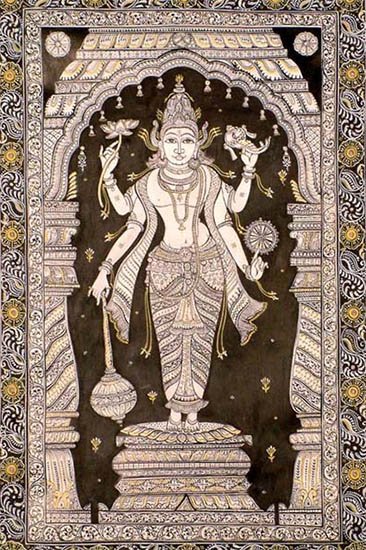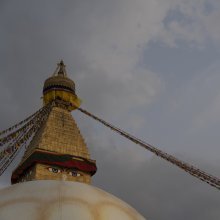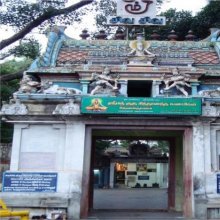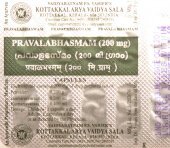Day: 11 definitions
Introduction:
Day means something in Hinduism, Sanskrit. If you want to know the exact meaning, history, etymology or English translation of this term then check out the descriptions on this page. Add your comment or reference to a book if you want to contribute to this summary article.
Images (photo gallery)
(+73 more images available)
In Hinduism
Natyashastra (theatrics and dramaturgy)
Source: Shodhganga: Elements of Art and Architecture in the Trtiyakhanda of the Visnudharmottarapurana (natya)Day (and Night) are associated with Sūcyāsyahasta: one of the twenty-two Single-hand Gestures (in Indian Dramas) (known as asaṃyuktahastas), according to the Viṣṇudharmottarapurāṇa, an ancient Sanskrit text which (being encyclopedic in nature) deals with a variety of cultural topics such as arts, architecture, music, grammar and astronomy.—The word sūcī means a tool which is used for stitching. It refers to the needle. [...] The Viṣṇudharmottarapurāṇa says that the natural phenomenon like day and night are denoted with this hand posture. It is also used to denote the eyes of Śakra and Maheśa.

Natyashastra (नाट्यशास्त्र, nāṭyaśāstra) refers to both the ancient Indian tradition (shastra) of performing arts, (natya—theatrics, drama, dance, music), as well as the name of a Sanskrit work dealing with these subjects. It also teaches the rules for composing Dramatic plays (nataka), construction and performance of Theater, and Poetic works (kavya).
Shilpashastra (iconography)
Source: Shodhganga: Elements of Art and Architecture in the Trtiyakhanda of the Visnudharmottarapurana (shilpa)Day and Night refers to classes of natural objects and phenomenon which follows specific guidelines in the tradition of ancient Indian Painting (citra), according to the Viṣṇudharmottarapurāṇa, an ancient Sanskrit text which (being encyclopedic in nature) deals with a variety of cultural topics such as arts, architecture, music, grammar and astronomy.—From the ancient period till today, natural phenomenon [like day and night, ...] always seem to inspire the artist to make beautiful creations. Even the sages in the Vedic period used to see the surroundings and could visualise everything as portraits in the mind. The Viṣṇudharmottarapurāṇa bears an elaborate description on the process of making the picture of some natural objects and phenomenon, e.g., Day and Night. Thus, the book addresses various elements of nature, such as day and night, since painting has much connection with time, mood and activity.

Shilpashastra (शिल्पशास्त्र, śilpaśāstra) represents the ancient Indian science (shastra) of creative arts (shilpa) such as sculpture, iconography and painting. Closely related to Vastushastra (architecture), they often share the same literature.
Yoga (school of philosophy)
Source: ORA: Amanaska (king of all yogas): A Critical Edition and Annotated Translation by Jason BirchThe Day can be denoted by the Sanskrit term Dina, according to the Amanaska Yoga treatise dealing with meditation, absorption, yogic powers and liberation.—Accordingly, as Īśvara says to Vāmadeva: “[...] [Now], I shall define the nature of that highest, mind-free absorption which arises for those devoted to constant practice. [...] Remaining in absorption for the [following] times; moments, breaths, Palas, Nāḍīs, Praharas, days (dina), months and years, [the Yogin] then goes to the highest reality. [...]”.

Yoga is originally considered a branch of Hindu philosophy (astika), but both ancient and modern Yoga combine the physical, mental and spiritual. Yoga teaches various physical techniques also known as āsanas (postures), used for various purposes (eg., meditation, contemplation, relaxation).
Languages of India and abroad
Sanskrit dictionary
Source: DDSA: The practical Sanskrit-English dictionaryDay (दय्).—1 Ā. (dayate, dayita)
1) To feel pity or compassion for, pity, sympathise with (with gen.) रामस्य दयमानोऽ सावध्येति तव लक्ष्मणः (rāmasya dayamāno' sāvadhyeti tava lakṣmaṇaḥ) Bhaṭṭikāvya 8.119; तेषां दयसे न कस्मात् (teṣāṃ dayase na kasmāt) 2.33; 15.63.
2) To love, like, be fond of; दयमानाः प्रमदाः (dayamānāḥ pramadāḥ) Ś.1. 4; Bhaṭṭikāvya 1.9.
3) To protect; नगजा न गजा दयिता दयिताः (nagajā na gajā dayitā dayitāḥ) Bhaṭṭikāvya 1.9.
4) To go, move.
5) To grant, give, divide or allot.
6) To hurt.
Source: Cologne Digital Sanskrit Dictionaries: Shabda-Sagara Sanskrit-English DictionaryDay (दय्).—[(ña) ñidaya] r. 1st cl. (dayate) 1. To give. 2. To move. 3. To take. 4. To protect. 5. To hurt or kill. bhvā0 ā0 saka0 seṭ .
--- OR ---
Dāy (दाय्).—[(ṛ) dāyṛ] r. 1st cl. (dāyate) To give. bhvā0 ā0 saka0 seṭ .
Source: Cologne Digital Sanskrit Dictionaries: Benfey Sanskrit-English DictionaryDay (दय्).—i. 1, [Ātmanepada.] (also [Parasmaipada.] [Bhāgavata-Purāṇa, (ed. Burnouf.)] 2, 7, 42). 1. To allot (ved.). 2. To have compassion, [Daśakumāracarita] in
— Cf. 2. dā and de.
--- OR ---
Dāy (दाय्).—i. 1, [Ātmanepada.] (properly 1. dā, i. 4, [Ātmanepada.]), To give.
— With the prep. ā ā, To seize, Mahābhārata 1, 7029.
Source: Cologne Digital Sanskrit Dictionaries: Cappeller Sanskrit-English DictionaryDay (दय्).—dayate (dayati) [participle] dayita (q.v.) divide, allot ([accusative] or *[genetive]); possess, partake; sympathize with, love ([accusative] or [genetive]); repent.
Source: Cologne Digital Sanskrit Dictionaries: Monier-Williams Sanskrit-English Dictionary1) Day (दय्):—[class] 1. [Ātmanepada] dayate (p. dayamāna, [Ṛg-veda] etc.; [Aorist] adayiṣṭa, [Bhaṭṭi-kāvya]; [perfect tense] yāṃ cakre, [Pāṇini 3-1, 37])
—to divide, impart, allot (with [genitive case], [ii, 3, 52]; [accusative] [Ṛg-veda]);
—to partake, possess, [Ṛg-veda; Nirukta, by Yāska];
—to divide asunder, destroy, consume, [Ṛg-veda vi, 6, 5; x, 80, 2];
—to take part in, sympathize with, have pity on ([accusative], [vii, 23, 5; Atharva-veda; Śatapatha-brāhmaṇa xiv; Bhaṭṭi-kāvya]; [genitive case] [Daśakumāra-carita; Bhaṭṭi-kāvya; Kathāsaritsāgara cxxi, 104]);
—to repent, [Ṛg-veda vii, 100, i];
—to go, [Dhātupāṭha] :—[Causal] ([Potential] dayayet) to have pity on ([genitive case]), [Bhāgavata-purāṇa ii, 7, 42] :—[Intensive] dandayyate, dād, [Vopadeva xx, 8 f.];—cf. ava-, nir-ava-, vi-.
2) Dāy (दाय्):—[class] 1. [Ātmanepada] dāyate ([Dhātupāṭha xiv, 9]) to give.
Source: Cologne Digital Sanskrit Dictionaries: Yates Sanskrit-English DictionaryDay (दय्):—(ṅa) dayate 1. d. To give; to move; to take; to protect; to hurt.
[Sanskrit to German]
Sanskrit, also spelled संस्कृतम् (saṃskṛtam), is an ancient language of India commonly seen as the grandmother of the Indo-European language family (even English!). Closely allied with Prakrit and Pali, Sanskrit is more exhaustive in both grammar and terms and has the most extensive collection of literature in the world, greatly surpassing its sister-languages Greek and Latin.
See also (Relevant definitions)
Starts with (+274): Day bong xanh, Day chi chi, Day dam cho, Day giun, Day mo vang, Day nhaajt, Day qua cong, Day ruot ga, Day-lily, Daya, Daya-aunu, Daya-dramma, Dayabandhu, Dayabhaga, Dayabhagakarika, Dayabhaganirnaya, Dayabhaganirnayaviveka, Dayabhagaprakasha, Dayabhagarthadipika padyavali, Dayabhagasiddhanta.
Ends with (+100): Abhishabday, Abhyuday, Amakiregadday, Amikkira-gadday, Anapanasati Day, Anushabday, Arunoday, Asmatsagrasanavyattavyalatunday, Asmatsamgrasanavyattavyalatunday, Attukkitay, Avaday, Baladay, Barunday, Bhagyoday, Bugday, Caday, Cam thao day, Camutay, Catay, Chan bat day.
Full-text (+7780): Tithi, Ahoratra, Aha, Dina, Diva, Sudina, Vasara, Purnima, Punyaha, Divasa, Caturdashi, Muhurta, Ahnika, Trayodashi, Ramanavami, Pratidinam, Akshayatritiya, Aharnisha, Ashtami, Adyatana.
Relevant text
Search found 505 books and stories containing Day, Dāy; (plurals include: Daies, Dāies). You can also click to the full overview containing English textual excerpts. Below are direct links for the most relevant articles:
Srila Gurudeva (The Supreme Treasure) (by Swami Bhaktivedanta Madhava Maharaja)
Taking Sannyāsa on Gaura Pūrṇimā, 1952 < [Chapter 1.6 - Return to Maṭha Life]
Introduction (Continued) and Entering Aprakaṭa-līlā
Introduction (when Śrīla Gurudeva started giving initiation) < [Chapter 2.5 - Their Intimacy Could Not Have Been Greater]
Kathasaritsagara (the Ocean of Story) (by Somadeva)
Part 1 - Betel-Chewing in India prior to a.d. 1800 < [Appendix 8.2 - The Romance of Betel-Chewing]
The festival of the Winter Solstice < [Notes]
The ten stages of love-sickness < [Notes]
The Matsya Purana (critical study) (by Kushal Kalita)
Part 4.4 - List of other Vratas described in the Matsyapurāṇa < [Chapter 4 - Religious aspects of the Matsyapurāṇa]
Part 4.2a - Akṣayatṛtīyā-vrata < [Chapter 4 - Religious aspects of the Matsyapurāṇa]
Part 4.2b - Śivacaturdaśī-vrata < [Chapter 4 - Religious aspects of the Matsyapurāṇa]
Puranic encyclopaedia (by Vettam Mani)
Bhagavati-sutra (Viyaha-pannatti) (by K. C. Lalwani)
Part 2 - Measure of day and night < [Chapter 1]
Part 1 - Questions of Merchant Sudarśana on Time < [Chapter 11]
Part 5 - Birth of Camarendra < [Chapter 2]
Manusmriti with the Commentary of Medhatithi (by Ganganatha Jha)
Verse 3.187 < [Section X - Method of Invitation]
Verse 4.95 < [Section XII - Vedic Study]
Verse 11.212 < [Section XXIX - Description of the Expiatory Penances]
Related products
(+351 more products available)











